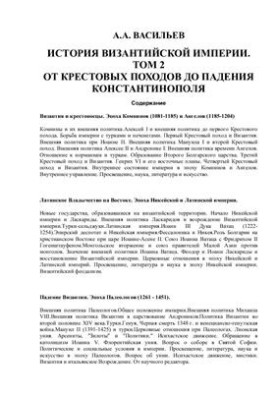History of the Byzantine Empire. Volume 2. Time from the Crusades to the Fall of Constantinople (1081-1453)
 Instant download
Instant download
after payment (24/7)
 Wide range of formats
Wide range of formats
(for all gadgets)
 Full book
Full book
(including for Apple and Android)
Per. with English. A. G. Pear. — SPb. Aletheia, 2000. — 968 s. "History of the Byzantine Empire" is an excellent example of the work of the general plan, where briefly, clearly, with a large number of references to the main sources and research is given a characteristic of all periods of the history of Byzantium. Foreign policy history is presented in full. The problems of inner history are treated unevenly, although the main problems of inner life of each period are touched upon or mentioned. Byzantines and Crusaders . The Age of Comnenians (108185) and Angels (118504). Byzantines and Crusaders . Committees and their foreign policy . Alexei I and foreign policy before the First Crusade . The Norman War . The Empire's Struggle with the Turks and Pechenegs . The First Crusade and Byzantium . Foreign Policy under John II . Attitude of John to the East . Foreign Policy of Manuel I and the Second Crusade. Relations with the Turks . The Union of Two Empires . The Second Crusade . Manuel's foreign policy after the Crusade. Foreign Policy of Alexei II and Andronike I. Foreign Policy of the Time of Angels . Formation of the Second Bulgarian Kingdom . The Third Crusade and Byzantium . Henry VI and his Eastern Plans[edit] The Fourth Crusade and Byzantium . The internal state of the empire in the era of the Comnenians and Angels . Internal management . Financial and Social Circumstances . Defence and Trade . Education, Science, Literature and Art . Latin Possession in the East. The Age of Nicaea and Latin Empire . Empire of Nicaea (1204261). New States Formed in Byzantine Territory . Beginning of the Empire of Nicaea and Lascarida. Foreign Policy of the Lascaris and the Revival of the Byzantine Empire. Seljuk Turks. The Latin Empire . John III Douka Watac (1222254). Epirus Despotate and the Empire of Nicaea . Thessalonica and Nicaea . Bulgaria's Role in the Christian East under Tsar John Asen II. Greek-Bulgarian Union . Union of John Wataz with Frederick II of Hohenstaufen . Mongol invasion and alliance of the rulers of Asia Minor against the Mongols. The Importance of Foreign Policy of John Watats . Theodore and John of Lascarida and the Restoration of the Byzantine Empire. Church Relations in the Age of the Nicaea and Latin Empires . Social and Economic Conditions in the Empire of Nicaea . Education, Literature and Science in the Age of the Empire of Nicaea . Byzantine Feudalism . The Fall of Byzantium . The Age of Paleologists (126151). The Fall of Byzantium . General position of the empire. Foreign Policy of Michael VIII . Byzantium and the Kingdom of the Two Sicilies . Charles of Anjou and the Sicilian Vespers . The Eastern Politics of Michael VIII . Foreign policy of Byzantium during the reign of Andronicus . Spanish (Catalan) squads in the East. Successes of the Turks in Asia Minor . Byzantium and the Rise of Serbia . Stefan Duan . Movement of Albanians to the South . Venice and Genoa . John V (1341-1391), John VI Kantakuzin (1341-1354) and the apogee of Serbian power under Stefan Dusan . Byzantine politics in the second half of the 14th century. Turks. Genoa, Black Death 1348 g. The Venetian-Genoese War . Manuel II (139125) and the Turks . Sigismund of Hungary and the Battle of Nicopolis . Expedition of Marshal Busico . Manuel II's Journey to Western Europe . Battle of Angora and its significance for Byzantium. The situation in the Peloponnese . Reform projects of Hemist Plyphon. Siege of Constantinople in 1422. John VIII (142548) and the Turkish threat. Constantine XI (144953) and the capture of Constantinople by the Turks. Church Relations with Paleologists . Union of Lyons . Arsenites, Zealots and Politicians . The Hesychastic Movement . Conversion to Catholicism by John V. The Florentine Union . The question of the Cathedral in Hagia Sophia . Political and social conditions in the empire. Education, Literature, Science and the Arts in the Paleologian Era . Question about the union . The Hesychastic Movement, Mystics . Byzantium and the Italian Renaissance . Applications. Applications from Science Editor. The Byzantine Emperors. Emperors of the Latin Empire, and rulers of the small independent states that existed in the territory of Byzantium after 1204 Patriarchs of Constantinople for the period 381-1453 .
LF/221628864/R
Data sheet
- Name of the Author
- Васильев А.А.
- Language
- Russian























